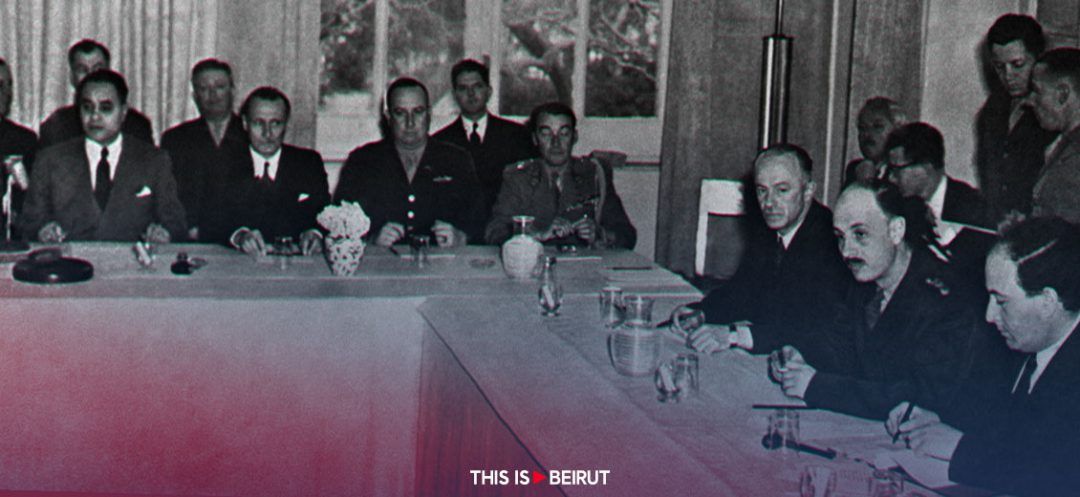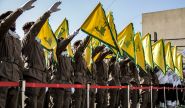
Since the beginning of the year, as part of diplomatic efforts to contain confrontations in southern Lebanon, Lebanese politicians have been referring to the 1949 armistice. On January 8, caretaker Prime Minister Najib Mikati declared that "all international decisions must be implemented, led by the 1949 armistice declaration."
More recently, on April 7, former leader of the Progressive Socialist Party, Walid Joumblatt, expressed hope for a return to the same agreement. From Ain el-Tineh, where he was received by Parliament Speaker Nabih Berri, he emphasized the need to "find a way to break the wall of hatred and reach an acceptable settlement for the implementation of resolution 1701 and a return to the armistice agreement."
But what is this 1949 armistice agreement?
Historical Background
On May 14, 1948, David Ben-Gurion, the founding father of Israel, proclaimed the State of Israel in Tel Aviv one day before the British mandate over Palestine expired. Following the proclamation of this new state, which was recognized by the major world powers, the first Arab-Israeli war broke out.
The Arab armies of Egypt, Iraq, Transjordan, Syria and Lebanon entered Palestine, but they were defeated. The war allowed for the expansion of Israeli territory, with its capital being East Jerusalem.
On January 7, 1949, a ceasefire ended the hostilities. With demarcation lines to be determined and pending issues to be resolved, a series of armistice agreements were concluded.
Negotiations began on the Greek island of Rhodes on January 12, 1949, and the agreement was signed on February 23, 1949, between Egypt and Israel. On April 3, 1949, a similar agreement was signed between the State of Israel and Transjordan. The discussions were facilitated by the United Nations mediator, Ralph Bunche, who was awarded the Nobel Peace Prize in 1950 for his role in the negotiations.
On their part, the Syrians reached an agreement on July 20, 1949, at the Israeli-Syrian border. In Lebanon, the document was signed in Ras el-Naqoura on March 23, 1949, by "Lieutenant Colonel T. Salem and Commander J. Harb on the Lebanese side, for and on behalf of the government of Lebanon."
Since Iraq did not share a common border with Israel, no agreement was reached, and its forces simply withdrew from the arena.
It was agreed that formal peace treaties would be signed subsequently. However, the lines drawn in Rhodes became de facto borders, later modified by other conflicts.
The Document
The text, the Lebanese-Israeli General Armistice Agreement, is divided into a preamble and eight articles, followed by an annex defining defensive forces. Let's examine some articles of this agreement.
Article I stipulates that military force shall not be used between the two parties in resolving the Palestinian issue. According to this article, armed forces (land, sea, air) shall not undertake or project any aggressive action against the population or armed forces of the other party.
Article III, given the current situation in Lebanon, may be the most interesting as it mentions military and paramilitary or irregular formations.
It is worth noting that during this first war with Israel, armed elements not belonging to the regular Lebanese armed forces crossed the border between Lebanon and Palestine, as well as the border between Palestine and Syria. These irregular forces of Arab volunteers fought under the banner of the Arab Liberation Army (ALA) created by the Arab League in September 1947. Led by Fawzi el-Qawakji, a former Syrian officer, the ALA was funded by all League countries. The nascent Lebanese army, under its then-commander-in-chief, Fouad Chehab, had to take its presence in southern Lebanon into account. On the Israeli side, the militias that prevailed during the British mandate were unified under the banner of the Israeli army upon the official proclamation of the State of Israel.
In Article III, we can read, "No element of land, naval, or air forces (military and paramilitary) of any of the parties, including irregular forces, shall commit any act of war or hostility against the military or paramilitary forces of the other party, or against civilians in the territory controlled by it; cross or cross for any purpose, the armistice demarcation line of this convention; enter or cross the airspace of the other party, or its territorial waters, within three miles of the coastline."
Article IV determines the fundamental purpose of the demarcation line as a limit that armed forces are not allowed to exceed, within which military forces will be defensive.
As for Article VII, it stipulates that the implementation of the provisions of the agreement shall be monitored by a Joint Armistice Commission which shall meet at the Naqoura border post (Lebanon) and north of Metula (Israel).
The Annex
The document attached to the agreement defines the defensive forces mentioned in Article IV. According to this text, no movement restrictions shall be imposed on both sides of the border as long as the demarcation line is not crossed.
Regarding defensive forces, each of the two countries could not have more than 1,500 military personnel, including officers and troops. On the Lebanese side, the military could not operate south of the general line "El Qasmiyé – Nabatiyé Ett Tahta – Hasbaiya." On the Israeli side, the armed forces could not operate north of the general line "Nahariya – Tarshisha – Jish – Marus."*
This limited military presence on both sides of the border and the exclusion zone between the two "general lines" outlined in the annex text closely resembles the same exclusion zone provided for in resolution 1701 south of the Litani River. Moreover, the text of resolution 1701 calls for respect for the Blue Line and emphasizes Lebanon's territorial integrity, sovereignty and political independence within its internationally recognized borders, as stipulated in the March 23, 1949 armistice agreement. Similarly, the UNIFIL press kit describes the Blue Line as the best approximation of the demarcation line of the 1949 armistice.
* The spelling is the one found in the official United Nations text.
Read more




Comments